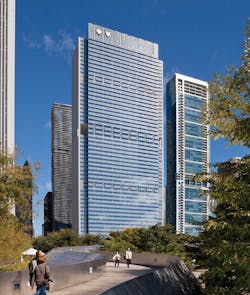A high-rise tour de force
Nearly a decade after construction was completed on a 33-story Chicago office tower, the owner outgrows the 1.43 million-sf building and initiates a vertical expansion that adds 24 stories atop the fully occupied structure. Fortunately, this was all part of the plan.
When constructed in the mid-1990s, the 33-story high-rise at 300 East Randolph in Chicago met the client’s immediate space needs but was designed for vertical expansion. The tower grew to 57 stories in 2010. Every third floor within the building’s atrium (opposite, right) was built out for meeting space.
When Chicago-based Health Care Service Corporation commissioned its office tower at 300 East Randolph Street in the mid-1990s, the organization asked for a building that could allow for future expansion. HCSC anticipated it was only a matter of time before it would outgrow the 33-story, 1.43 million-sf building. That time came in 2006.
HCSC, which operates several Blue Cross and Blue Shield insurance plans, called on Goettsch Partners, the building’s original architects, to guide the expansion based on the original plan. The Chicago-based firm pulled the original drawings and completed the design for Phase 2: a 24-story, 920,000-sf addition atop the existing 33-story structure.
Goettsch Partners calculated that adding a second tower on the site would have cost $15 million more than going vertical. So when the original building was completed in 1997, all the necessary internal components for future upward exapansion—structural, MEP, and elevator accommodations—were already in place.
“The original building was so tied to client need that their program allowed this second phase,” noted Building Team Awards judge Michael Damore, AIA, Executive Managing Director and President of Architecture and Interior Design at Epstein, Chicago.
Nonetheless, the new Building Team, which included The John Buck Company (development manager), Walsh Construction (contractor), Magnusson Klemencic Associates (structural engineer), and Cosentini Associates (MEP), were still faced with a project of enormous complexity.
Construction atop an occupied building. An “intricate ballet.” That’s what some at Walsh Construction called the erection of cranes on the building’s roof and the subsequent erection of the steel structure. In order to choreograph the work, the team built a scale model of the roof, steel structure, two derrick cranes, and two tower cranes so they could coordinate proper access, equipment positioning, and working radius—with all of this occurring 33 floors above a tight urban site, of course.
As the new structure rose above the building, existing rooftop cooling equipment had to remain operational. The cooling towers were left exposed to allow for air circulation. When the addition was topped off, high-performance cooling equipment was installed on the roof and the original equipment was decommissioned.
Noise abatement. The neighborhood around 300 East Randolph Street had changed considerably in the intervening years. What originally was an office district had evolved into a mixed-use community of offices, hotels, and multifamily buildings—not to mention that the Pritzker Pavilion was hosting outdoor performances across the street in Millennium Park. The Building Team made significant accommodations on work hours to keep construction noise from disturbing office occupants, neighbors, and concert goers.
Elevator additions. The original building’s atrium was designed to accommodate additional passenger elevator banks, as well as the skip hoist used to deliver construction workers and materials to work areas. The atrium comprises five 40x30-foot open structural bays located along the north façade; each of the outer bays holds an eight-car bank servicing the original 33 floors. Two new eight-car elevator banks were added (at night, to minimize disruption) to the inner bays. The center bay was retained for an open staircase to facilitate circulation between floors; every third floor was built out for meeting space.
As for the skip hoists, conventional practice would have called for running them on the exterior of the building, but that would have required removing curtain wall from the original building and taking portions of the building out of commission during construction. Instead, the Building Team ran the skip hoists through the atrium—a brilliant engineering solution.
Façade detailing. Architects at Goettsch Partners had to ensure a cohesive look could be achieved between the two building phases, so they specified timeless materials that aged well: high-performance curtain wall, stainless steel, and stone. The completed 57-story tower has a unified appearance despite the effects of a decade of ageing between the two phases. “The building doesn’t look at all dated, not even the original structure, which is 14 years old,” said Building Team Awards judge John (Jay) Frisco, AIA, NCARB, an associate with RTKL in Chicago.
Now that HCSC has nearly doubled its floor space, it’s not likely to outgrow 300 East Randolph anytime soon. Currently, 64% of the building is occupied, and most of the remainder is being readied for occupancy later this year. Moreover, the organization has signed a top-tier law firm as a tenant for 264,000 sf of space on the new floors.
